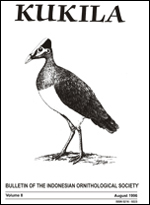The birds of Tinjil and Deli Islands, West Java
 Abstract views: 394
,
Abstract views: 394
,
 PDF downloads: 133
PDF downloads: 133
Abstract
Pulau Tinjil and Pulau Deli are islands of 600 ha and 950 ha respectively lying 14 km off the south coast of West Java. The authors made six visits to one or other of the islands between 1988 and 1995. Both are covered with primary forest, but a large population of Long-tailed Macaque monkeys has recently been introduced on both islands as a free-range monkey-breeding facility. The islands have an depauperate avifauna with probably just 20 resident landbird species, common to both islands. These include one near-threatened species, the Nicobar Pigeon, which was formerly very common but which may have suffered as a result of the introduction of monkeys. Other small island/coastal specialists include the Beach Thick-knee, Pied Imperial Pigeon and Chestnut-capped Thrush. Except along the beaches, there are few forest-edge habitats, and most of the landbirds, including those normally occupying open habitats on the mainland such as White-breasted Waterhen, Yellow-vented Bulbul and Brown-throated Sunbird, have expanded their range to occupy the forest niche
Downloads
Download data is not yet available.
How to Cite
Holmes, D. A., & van Balen, B. (1). The birds of Tinjil and Deli Islands, West Java. KUKILA, 8, 117-126. Retrieved from https://kukila.org/index.php/KKL/article/view/171
Issue
Section
Full Articles
Authors who publish with this journal agree to the following terms:
- Authors retain copyright and grant the journal right of first publication with the work simultaneously licensed under a Creative Commons Attribution License that allows others to share the work with an acknowledgement of the work's authorship and initial publication in this journal.
- Authors are able to enter into separate, additional contractual arrangements for the non-exclusive distribution of the journal's published version of the work (e.g., post it to an institutional repository or publish it in a book), with an acknowledgement of its initial publication in this journal.
- Authors are permitted and encouraged to post their work online (e.g., in institutional repositories or on their website) prior to and during the submission process, as it can lead to productive exchanges, as well as earlier and greater citation of published work (See The Effect of Open Access).




